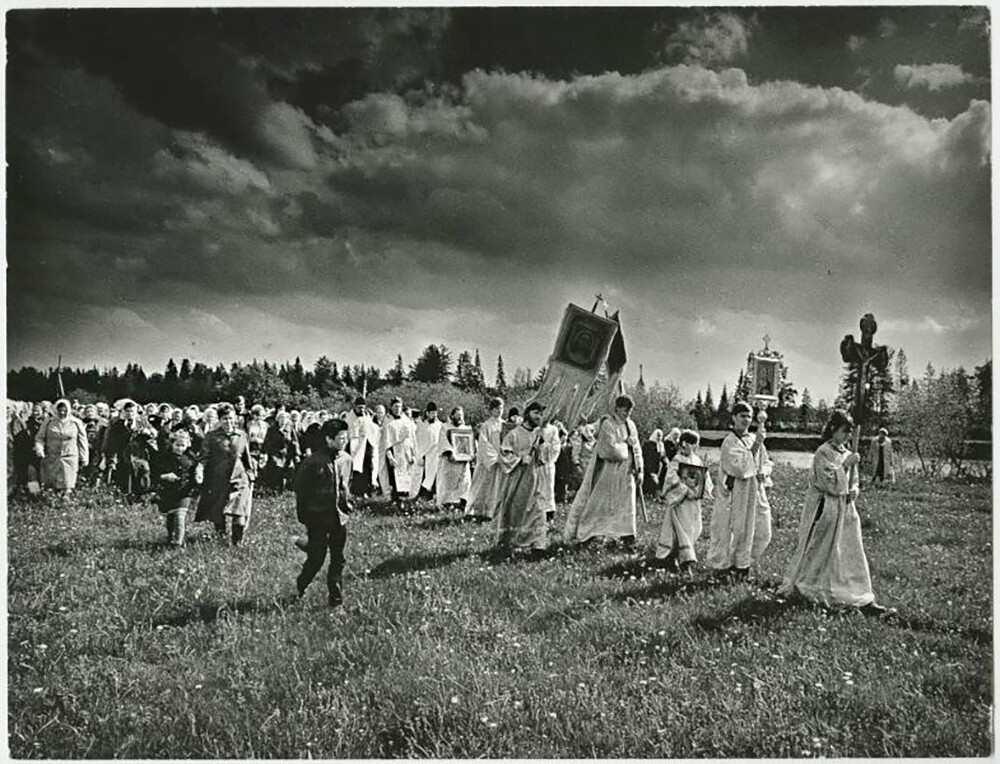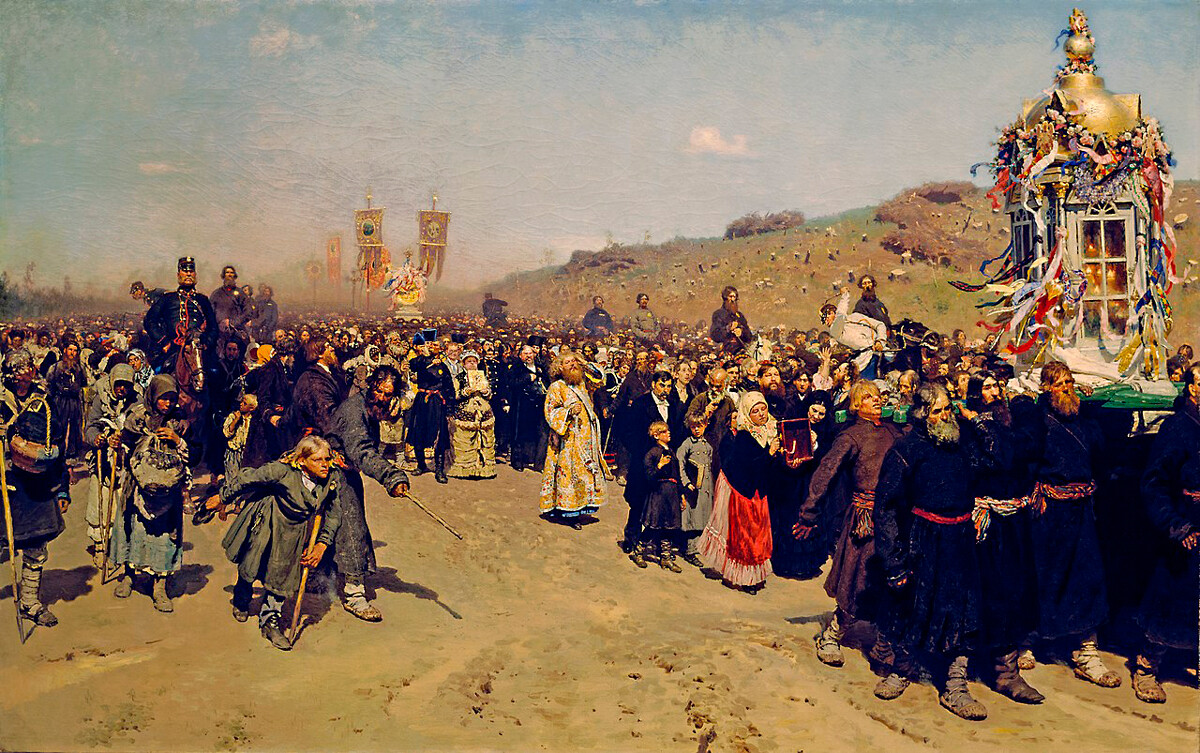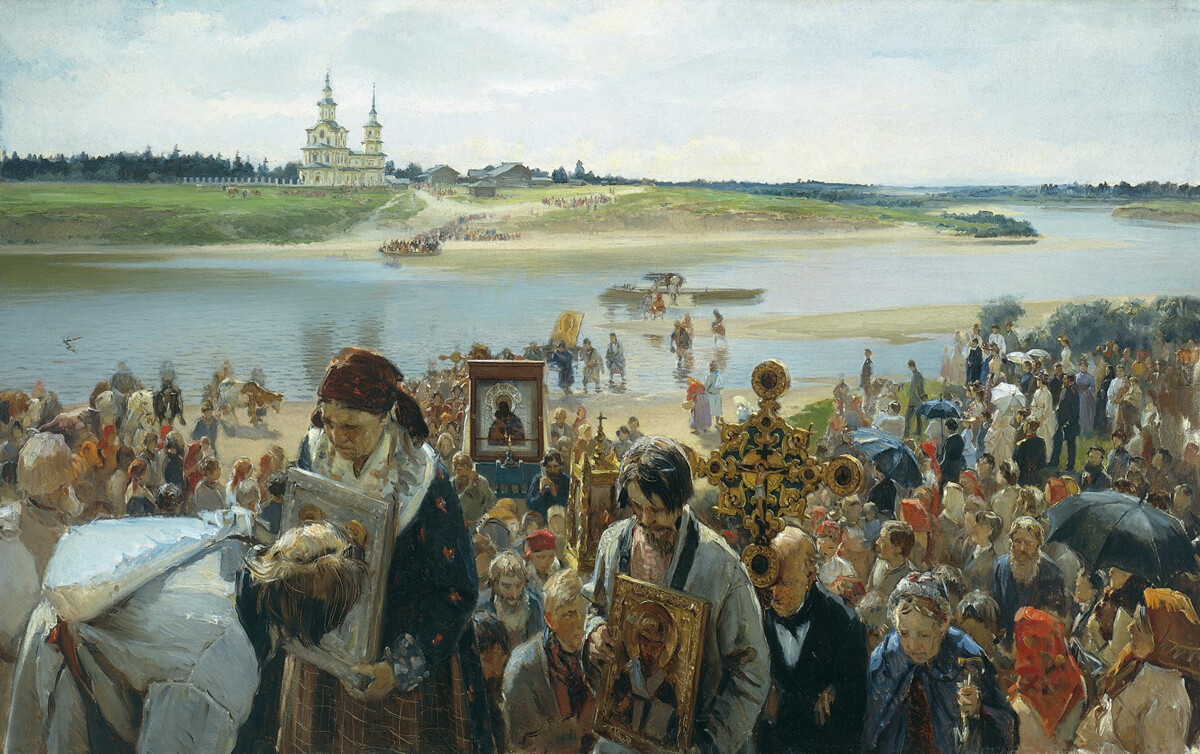
The walk of the cross near the walls of the Solovetsky Monastery
Sergey Metelitsa/TASSIn Russian, krestnyi khod (крестный ход, literally ‘the walk with the cross’) isn’t capitalized, because it is not some certain procession, but a usual form of religious service that persists in the life of every Orthodox Christian.
The first walk of the cross every Christian takes is the one they perform around the baptismal font immediately after the sacrament of Baptism. Most Christians do this while being held by adults, since they themselves are still infants. According to the rules of the sacrament of Baptism, after a threefold immersion into the font and after anointing the newborn child of Christ with the scared myron (chrism), the newly baptized one makes three circles around the font behind the priest, who holds the cross in his hand. If an infant is baptized, it is carried in the arms of his godparent.

Walk of the cross in Novgorod, 1990s
Stanislav Shaklein/MAMM/MDF/russiainphoto.ru/The walk of the cross is a special service, during which the congregation of believers follow the Holy Cross and the icons, priests and a choir, singing psalms and prayers. They go around a particular place – for example, a temple or a city – or go towards it. The peculiarity of the procession is that the walk of the cross is often performed outside the walls of the church, and so, becomes open to all.

'Seven Trumpets of Jericho' by James Tissot
The Jewish Museum, New York/Public DomainThe walk of the cross is an ancient Christian tradition, although it is not mentioned by that name in the Bible. The Old Testament speaks of two such processions: the circumambulation of the walls of Jericho with the Ark of the Covenant and the carrying of the Ark of the Lord by kings David and Solomon. These processions can be thought of as a prototype of the walk of the cross, as was the entrance of Jesus into Jerusalem, when Christ was accompanied by the people who cried: “Blessed is the King of Israel who comes in the name of the Lord!”
It is believed that walks of the cross appeared as a response to the heretical processions conducted by the Arian heretics in Constantinople in the time of John Chrysostom (4th century A.D.). In contrast, Christian processions with the singing of psalms, litanies, hymns and prayers were instituted. From the Byzantine tradition, the procession passed on to Russian Orthodox Christians.

'The walk of the cross in the Kursk governorate,' by Ilya Repin
Tretyakov gallery/Public domainWalks of the cross are divided into church ones (authorized) and voluntary. Church ones are conducted as an obligatory part of the Divine Liturgy. For example, the procession on Easter, the procession to the pond on Epiphany and the threefold circumambulation of the church by the faithful after its consecration.
READ MORE: 7 main differences between Catholicism and Russian Orthodoxy
Voluntary walks of the cross are performed by the decision of the priest. These include, for example, processions with prayers in the fields during drought or processions in memory of saints or cases of miraculous help from God.
In terms of time, the walks of the cross can be one-day (most often) and multi-day, when believers walk many kilometers with stops for overnight stays.

'The walk of the cross,' 1893, by Ivan Pryanishnikov
The Russian Museum/Public domainIn the 17th century, the question of the direction of the walk of the cross became one of the key issues in the dispute between supporters of the “old” and “new” Orthodox rites. Traditionally, the walk of the cross was performed in a clockwise or sunward direction. The Nikon reforms directed this movement against the sun (counterclockwise), which became the subject of controversy and one of the causes of the Raskol of the Russian Orthodox Church.
Over time, however, the walks of the cross became one of the few rituals that brought the Old Orthodox Believers and Nikonians together. Since the schism of the Russian Orthodox church in 1653, Old Believers had been forbidden to conduct walks of the cross, ring bells, erect churches and so on. However, the Old Believers did not cease to praise the Lord. At the same time, many revered ancient icons were inside the new temples where Old Believers were forbidden to enter. It turns out that the walk of the cross, during which the crosses and holy images were taken out of the temple, was the only chance for Old Believers to pray to them.
The main point of any walk of the cross is formulated as early as the Gospel of Matthew: “Where two or three are gathered together in my name, there am I in the midst of them,” says Jesus. Those who march behind the cross and icons in solemn procession believe that spiritually, they are being led by Jesus himself.
Dear readers,
Our website and social media accounts are under threat of being restricted or banned, due to the current circumstances. So, to keep up with our latest content, simply do the following:
If using any of Russia Beyond's content, partly or in full, always provide an active hyperlink to the original material.
Subscribe
to our newsletter!
Get the week's best stories straight to your inbox